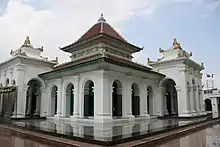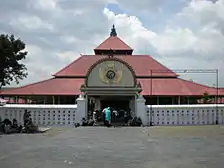Tuo Koto Nan Ampek Mosque
Tuo Koto Nan Ampek Mosque, also known as Gadang Balai Nan Duo Mosque is one of the oldest mosques in Indonesia located in Koto Nan Ampek Nagari, now administratively included into the area of Balai Nan Duo village, West Payakumbuh District, city of Payakumbuh, West Sumatera.[2] The Minangkabau architecture is thought to have been built in 1840, which was originally covered with fiber roofs before being replaced with zinc.[3][4] Currently other than being used for Muslim worship activities, this single-level mosque is also used by the surrounding community as a means of religious education.[5]
| Tuo Koto Nan Ampek Mosque Masjid Tuo Koto Nan Ampek | |
|---|---|
 | |
| Religion | |
| Affiliation | Islam |
| Leadership | Waqf |
| Location | |
| Location | Koto Nan Ampek Nagari, Payakumbuh, West Sumatra, Indonesia |
| Architecture | |
| Type | Mosque |
| Style | Minangkabau |
| Completed | 1840 |
| Specifications | |
| Capacity | 500 pilgrims[1] |
| Length | 20 m |
| Width | 20 m |
| Dome(s) | 0 |
| Minaret(s) | 0 |
History
It is not known when exactly the mosque was begun building. According to an author Abdul Baqir Zein in his book entitled Historical Mosques in Indonesia, the mosque was estimated to be built in 1840 and named after its establishment, Koto Nan Ampek Nagari.[6] The construction was led by three different leaders from respective tribes in Minangkabau: Datuk Kuniang from the Kampai tribe, Datuk Pangkai Sinaro from Piliang tribe, and Datuk Siri Dirajo from Malayu tribe.[2][4]
Although it is one of the oldest mosques, most of the masts, floors, and walls made of wood have never been replaced since the first time the mosque was built.[5] The mosque hasn't undergone many renovations thus its authenticity is still maintained.[7][8] Because of erosion, however, the roof which was originally made from fibers was then replaced with zinc.[4]
See also
References
- Footnotes
- Padang Ekspres 2011.
- Departemen Agama Indonesia 2008.
- Gayo 1985, pp. 178.
- Balai Kajian dan Pengembangan Budaya Melayu 2011.
- Zein 1999, pp. 47.
- Zein 1999, pp. 45.
- ANTARA 2008.
- Indonesia Travel.
- Bibliography
- Zein, Abdul Baqir (1999). Masjid-masjid Bersejarah di Indonesia. Jakarta: Gema Insani. ISBN 979-561-567-X. Retrieved 2012-07-29.
- Gayo, Iwan (1985). "Masjid Bersejarah di Indonesia". Buku Pintar Seri Senior. Grasindo. ISBN 979-025-294-3.
- Sekretariat Wakil Presiden Indonesia (2008). Direktori Masjid Bersejarah. Jakarta: Departemen Agama Indonesia. ISBN 979-25-0050-2.
- "Masjid Tuo Koto Nan Ampek". ANTARA. 2008-06-25. Retrieved 2012-08-03.
- "Masjid Bersejarah Nagari Koto Nan Ampek, Payakumbuh, Sumatera Barat". Melayu Online. Balai Kajian dan Pengembangan Budaya Melayu. 2011-05-28. Retrieved 2012-07-29.
- "Payakumbuh: Keindahan Alam Berbalut Nikmatnya Batiah". Indonesia Travel. Kementerian Pariwisata dan Ekonomi Kreatif Indonesia. Retrieved 2012-07-29.
- "Sambut Puasa, Tabligh Akbar Digelar". Padang Ekspres. 2011-07-26. Retrieved 2012-07-29.










